Australia was once self-sufficient in rice. We now grow less than 25 percent of domestic rice consumption. The SunRice Group has been importing rice from Vietnam and repackaging it to make-up the shortfall. Since the Corona Virus pandemic, the Vietnamese government has banned the export of rice, while the Australian Bureau of Meteorology has feigned an unprecedented drought. There is a need to not only prioritise health needs, but also to ensure we can feed ourselves. This could go together with the restoration of the Murray River’s estuary.
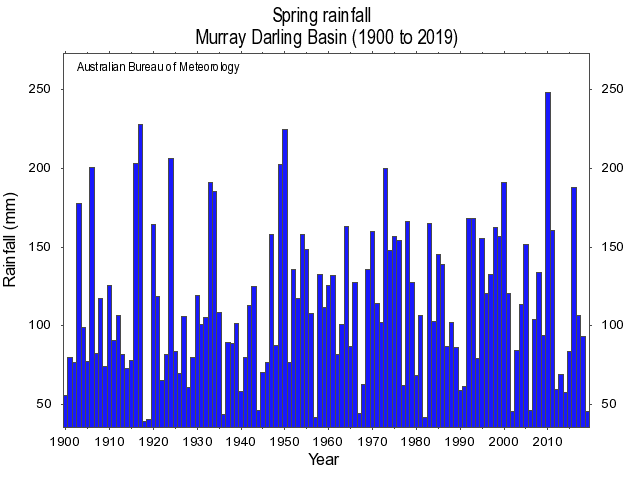
I have been fortunate to live most of my life through the good times, and in a society so rich and well serviced that we flush our porcelain toilet bowls with water good enough to drink. At the same time, many have complained endlessly about a coming environmental apocalypse, unless all the travel stops, and we allocate ever more water to the environment. Now the travel has stopped, and also the rice growing, but not because of climate change or a shortage of freshwater.
We have a pandemic, and across the world communities have shown that they can do the right thing. Across the world, governments have put saving lives before capitalism and populations have mostly complied. We have been told to stay at home, and we mostly have. In Australia, department store giant Myer will closed from today. Around 10,000 staff will be stood down. Early last week, Qantas announced it was cancelling 90 percent of international flights. A couple of days later the borders were closed to everyone except Australians and Australian residents. My daughter was on the second last Qantas flight from the United States to Sydney, before the entire international Qantas fleet was grounded. She arrived the same day my home state of Queensland began turning back anyone who was not a resident, anyone who didn’t already live here.
She has spent the last few years overseas, most recently working in New York. She has told me that what was most disturbing about her last week there, in South Harlem Manhattan, was the surge in frequency of the sound of ambulance sirens.
New York has quickly become the global epicentre for Corona virus. A virus with its origins apparently in a seafood market in China that also sold wild animals kept alive in cages. Environmentalist Jane Goodall recently said that if anything good has already come from this virus, it is the closing down of that cruel trade. The market was in Wuhan which is a city on the Yangtzee River, where just a few years ago the Baiji went extinct. The Baiji was a grey dolphin endemic to the Yangtze River with tiny eyes and a long narrow beak. The last confirmed sighting was in September 2004.
The Baiji, Lipotes vexillifer, may be the first species of cetacean (whale, dolphin and porpoise) to go extinct in modern times. The extinction will have taken place at a time of unprecedented interest and concern for their large relative the Minke whale. It is perhaps a sad reflection of humanity’s sometimes inability to prioritise effectively on the basis of need, that so many resources and so much publicity has been devoted to ‘saving’ these whales whose populations are relatively abundant, while their endangered cousin was left to die out. In the same way we have been wasting water in the Murray Darling Basin on propping-up a crippled estuary when we could have been growing rice while restoring that estuary by bringing back the sea tides.
NO RICE IN THE SUPERMARKETS
Friday I was food shopping for my daughter now in a mandatory 14-day period of quarantine. I was surprised that there were no bags of standard rice on the shelves in my local Woolworths supermarket. Yesterday I went to Aldi specifically to buy some brown rice, but the line was so long – the line of people waiting just to enter that shop – that I will instead take her rice from my own pantry. Hopefully, the hoarding of food, as the Prime Minister, has described it, will stop. But is anyone in government a reliable source of information when it comes to claims there is enough rice to go around?
I phoned my friend Debbie Buller, who is a rice farmer on the Murrumbidgee River.
“There is no rice here, either,” she said. “Normally at this time of year we would be harvesting. But we have not been given a timely or adequate water allocation to grow rice for some years now.”
There have been claims that the recent drought was ‘unprecedented’, when in reality it was a very wet spring just a few years ago in 2016, in the Murray Darling Basin. Australia-wide the incident of drought has been decreasing since the 1970s and rainfall has generally been increasing. Yet since the summer of 2016-2017, rice growers have been denied a timely water allocation. The reservoirs and the rivers had enough water, but the government institutions responsible for water allocation have given Debbie very little. The mood has been against farming, and particularly against farming rice.
NO WATER FOR RICE GROWING
The Basin Plan has prioritised water for South Australia, and in particular the lower lakes that have been designated a wetland of international importance, even though they are only freshwater by artificial means since construction of the 7.6 kms of sea dyke back in the 1930s that stopped the tide.
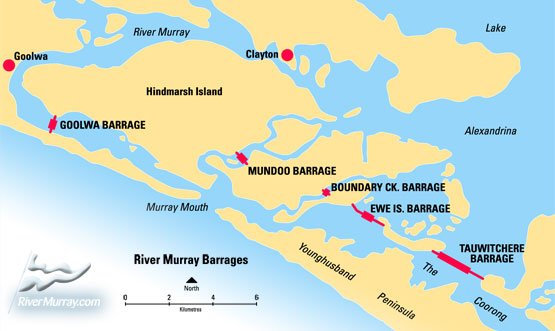
The taxpayer-funded Basin Plan is meant to be about restoring the environment, but it ignores the first thing that should be considered when fixing a river system — that is the need to restore the estuary to its natural dynamic state, as I explained to a Senate Committee in December 2015.
The bottom-line is that successive governments have denied upstream irrigators water in an attempt to keep forcing what was once the Murray River’s estuary to remain as an artificial freshwater lake. The water from upstream storages is sent to South Australia and much of it lost to evaporation, including in transmission. The Lower Lakes, that were once a functioning estuary but now barraged in as entirely freshwater, lose in excess of 800,000 megalitres of fresh water each year in evaporation, water that could be used to grow rice and other important staple food crops.
If my good friend Debbie had just 2,000 megalitres (0.25%) of that water that is evaporated, she could grow 2.16 million kilos of rice on just 174 hectares (430 acres). This would go some way to returning us to self-sufficiency. Once upon a time, over the ten years to 2004, Australian rice farmers grew 1 million tonnes of rice in an average year; we were self-sufficient. In Australia we could easily grow enough rice to feed about 20 million people a meal of rice every day of the year. Instead, again this last summer there has been very little rice planted, and not nearly enough available in the Murrumbidgee or Murray River irrigation areas to restock the supermarket shelves.
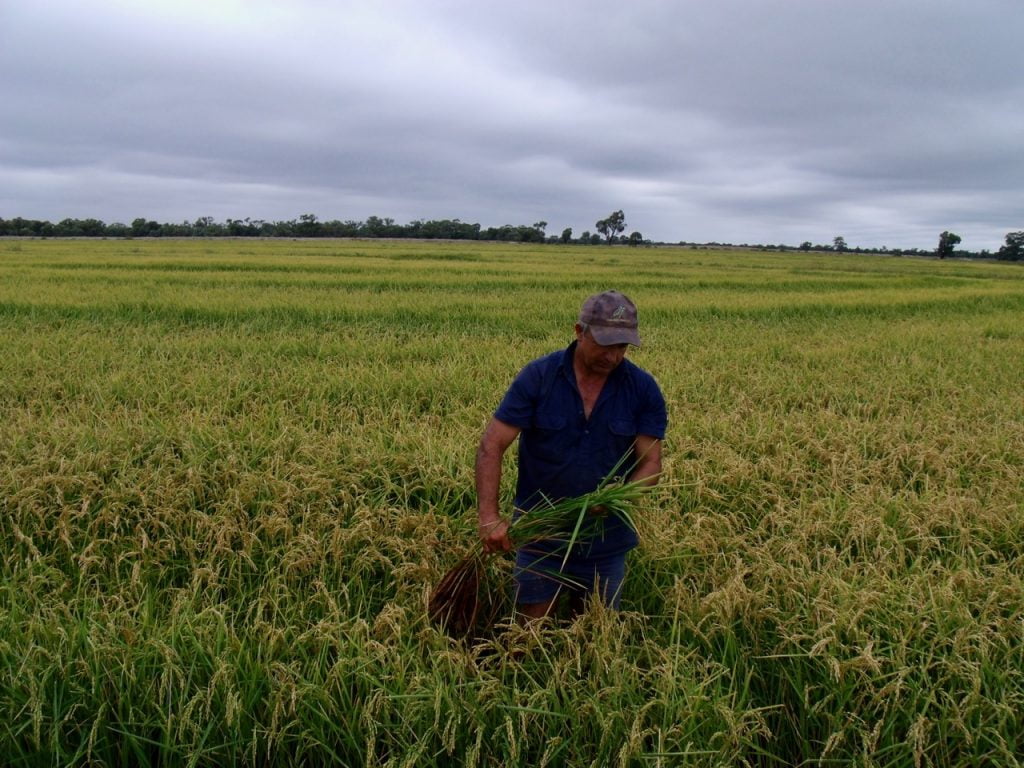
NO WATER, NO RICE, MILL CLOSED
A consequence was the virtual closure of the Deniliquin rice mill just last year, and the loss of 250 jobs.
To overcome the declining reliability of Australian grown rice because of changing government policy and public sentiment, the SunRice Group decided to instead invest in a mill where there was a reliable supply of rice.
They bought a rice mill in Vietnam with the intention of shipping the Vietnamese rice to Deniliquin for packing and distribution around Australia. Except, we live in unprecedented times, and the Vietnamese government has just banned the export of rice. So, the SunRice Group can no longer bring the Vietnamese rice back to Australia. There is not enough rice right now in Australia to restock the supermarket shelves, and none has been planted.
NEED FOR POLICY CHANGE, REMOVE THE SEA DYKES
Debbie and so many other rice growers would like to grow rice this next summer. But they have no idea whether they will be allocated any water. This situation needs to change. There is already more than enough water in the reservoirs for farming and the environment, if only the Murray River’s estuary were restored. The sea dykes need to be removed and the estuary restored. Then the 800,000 megalitres of water that is evaporated each year could be supplemented with saltwater, depending on the tides.
Once upon a time each spring, after good rains and snow melt, the Murray would tumble down from the Mountains spread over the vast Riverina and wind its way through the limestone canyons of the Riverland before flooding into Lake Alexandrina. By New Year, the river exhausted, and a breeze picking up from the southwest, the Southern Ocean would pour in through the Mouth of the river, and with the seawater came vast schools of Mulloway fish.
The fish came each autumn to spawn. The sea would work its way up across the lake and sometimes into the river proper. And so, the lakes would be sometimes fresh and sometimes salty, but always full of water and each autumn full of Mulloway.
Then the massive steel and concrete barrages were built across the Goolwa channel, that was after the dykes were already built sealing the Mundoo, Boundary Creek, Ewe Island channels and also the Tauwichere fishing area. In the autumn of 1940, the year the Goolwa barrages were completed and sealed, the Mulloway entered the Mouth, passed along the Goolwa channel and died in their hundreds of millions entrapped between the barrier and the falling tide.
The sea dykes killed the Mulloway fishery and crippled the estuary.
In 1939, the annual mulloway catch by commercial fishermen in the Murray River’s estuary was 595 tonnes. There is no longer an estuary; the Mulloway are stopped by the sea dykes. The catch in the adjacent Coorong has been no more than 30 tonnes in recent years.
The technical literature explains the sea dykes and Goolwa barrage reduced the size of the estuary by 89 per cent, and flows to the Murray mouth by 75 per cent. They stopped the tides. We are left with a freshwater lake full of carp instead of an estuary with Mulloway, crabs, waders and the biodiversity that comes when there is natural mixing of fresh and salt waters.
CONSEQUENCES OF HOLE DIGGING AND INFILLING
Some of us have been warning that as a civilization, it is best we not squander our wealth because bad things do happen. They are happening now. ‘Mr FOIA’, the sceptic and the good hacker who brought us Climategate, he warned back in 2009 that:
“[The] Wealth of the surrounding society tends to draw the major brushstrokes of a newborn’s future life. It makes a huge difference whether humanity uses its assets to achieve progress, or whether it strives to stop and reverse it.”
In the same email he described the misguided obsession with human-caused catastrophic global warming as “a massive hole-digging-and-filling-up endeavour”. The obsession has extended beyond climate change to so many aspects of natural resource management. It is the case that during the 1980 there were salinity issues in the Murray Darling Basin, caused in large part by rice farming. But the problems were solved through clever drainage management thirty years ago.
It is difficult to understand why this good news about environmental restoration is so rarely reported. Instead the Australian Broadcasting Corporation (ABC) continues to vilify those who defy agreed narratives when it comes to Australia’s longest river system, the Murray. Both sides of politics court the South Australian vote, and South Australians always want more freshwater including for the golf courses, wineries and the Goolwa sailing club that is just upstream of the barrage.
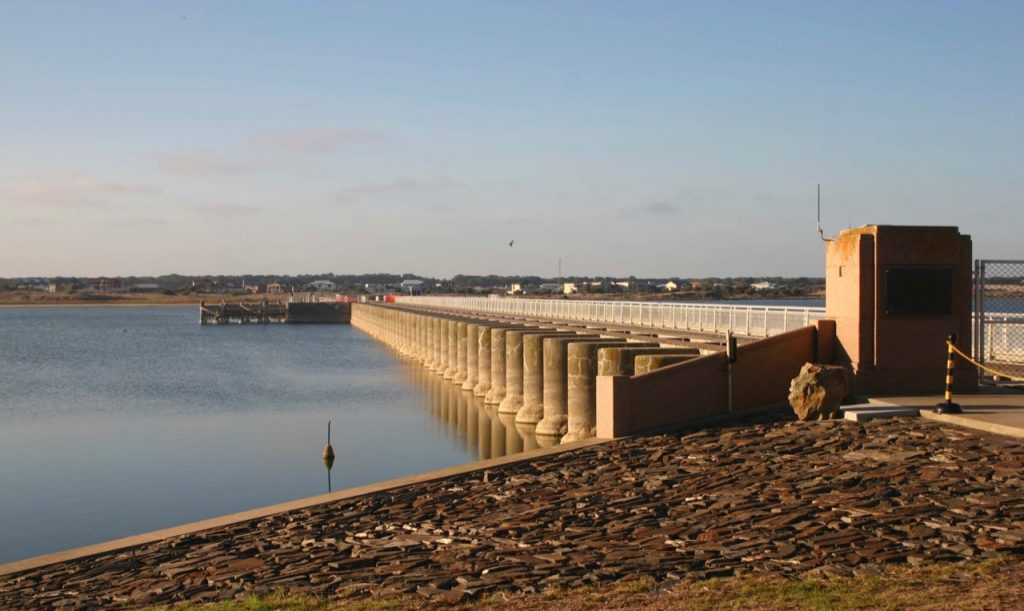
TIME TO SORT PRIORITIES
Now is the time to be honest to the evidence, to stop the waste, stop the politics and assure Debbie Buller some water for this summer, so she can grow rice for the thousands of people queuing for hours across Australia, trying to access staple food.
Denying Australian rice-growers water will not make it rain during drought, nor will it bring back the Yangtzee River dolphin or stop the spread of Corona virus. Restoring the Murray River’s estuary could though bring back the Mulloway fish. We are seeing for example in the many reports already of dolphins returning to Venice canals and clear skies over long-polluted cities, how resilient nature can be when we get out of the way.
On 11 March 2020, the World Health Organisation (WHO) declared a global pandemic, and the world community has responded closing whole industries including the travel industry. This health emergency could develop into a food emergency if we continue to hoard food, and if government policies continue to deny farmers access to water.
The SunRice Group have commenced discussions with the Australian government around the potential for an allocation of water to be made available to Australian rice growers who are upstream, this must be ahead of the planting window later in 2020 to ensure continued supply of Australian-grown rice for domestic consumption. Now is the time for sanity, for water to be allocated for farming so Australia can once again be self-sufficient in rice. But this is not enough, now is also the time to restore the once mighty Murray River its estuary.
The Chinese have banned the trade in exotic wildlife at that market in Wuhan. Now the Australian government can dismantle the 7.6 kilometres of sea dyke that deny the wild Mulloway their estuary. That would be a good start in getting out of the way, bringing back the sea tide, and filling our supermarket shelves with rice.

****
The feature photograph at the very top of this post is of Debbie Buller on her tractor in the Murrumbidgee Irrigation Area (MIA). This next spring she would so like to be planting rice.

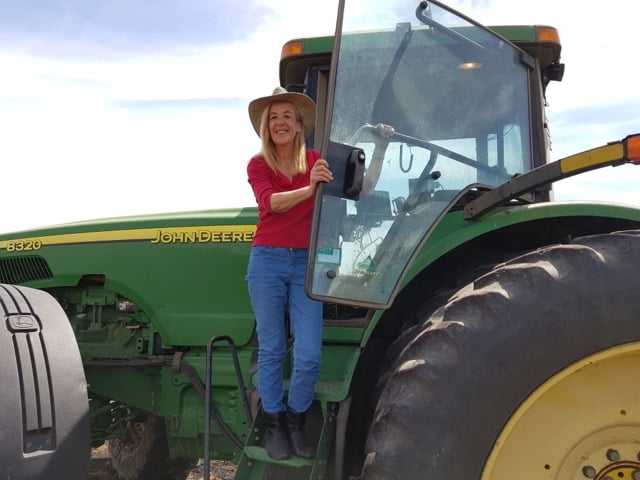
 Jennifer Marohasy BSc PhD is a critical thinker with expertise in the scientific method.
Jennifer Marohasy BSc PhD is a critical thinker with expertise in the scientific method.

MIA – Missing In Action, is the best way to describe the lack of real leadership in my once lucky country.
Jennifer’s expose on the waste of water resources to deny agricultural production to feed the country is a scandal of immense proportions.. Urgent attention must be taken by those responsible to correct what is blatantly dumb to start with, negligent at best, criminal at worst, particularly in our current crisis.
My MP will be pestered, yet again, to do something about feeding our country in times of need with our own resources as the best solution for the nation.
It’s time for change not allowing our farmers the water they paid for and need is a disgrace. This should be actioned now and turn on the taps and open the gates, we are in a time of need and we will be at our farms to keep this great country feed. This should have never happened in the first place so now it’s time to fix this major stuff up. Give our farmers the water back.
Reading this it’s all about South Australia. They created these estuary problems themselves, they can fix them. Return the water to the Riverina & Victorian flood plains where it has spread for millions of years. Let these irrigators go back to growing the bulk staple foods as in the past. For far too long water issues have been driven by politically motivated Government stupidity from the top down. Australians have never been hungry & should never have to be , but the future is certainly leaning that way. With this pandemic world wide, what country would be exporting their produce. Let common sense enter.
Thank you for the post, Jennifer. As always, it was well done.
Stay safe and healthy,
Bob
Well said Jennifer. Time NSW told SA where to get off. Turnbull, Pyne and Xenophon are responsible for potentially starving Australians by trading rice growing water for same sex marriage votes! What a joke.
MIA and Coleambally irrigators should just take the water and grow crops.
This really does seem like a no-brainer to me.
Grow some balls and give them the natural resource they need to grow our food and feed our kids. WATER IS FKN FREE COMES FROM GOD.
When politicians of the past few years ignored real nature’s facts in favour of policy direction then disaster will strike. If food were to be denied to the politicians, we then might see sensible food production policies appearing overnight.
Great post.
The problem is..the public servants cant admit they were wrong so will not change the situation.
Their Australian Brainwashing Corporation cant admit they were wrong either on this as well.
A cool narrative made up of a farrago of mendacious tripe….appears to be the dominate meme.
Post modernism wins again…
Australia has a lot of resources that’s the envy of the World, yet these resources are blatantly ignored and mismanaged. It’s time all Australians take hard look at these resources and harvest them sustainably. Water is a valuable resource and should be shared equitably. In the near future, Australia needs to be self sufficient in everything, that includes food production, mining, power generation, manufacturing industries, innovation etc.
Growing rice in the driest continent on Earth is just madness.
***
Hey Frank
Not sure what statistics you are quoting, but it could be that you spend far too much time listening to state-sponsored propaganda. Turn off the ABC. It is a disgrace.
Here are some statistics you may not agree with:
According to the World Resource Institute, Australia has 51,000 litres of available water per capita per day. This is one of the highest levels in the world, after Russia and Iceland, and well ahead of countries such as Indonesia (33,540), the United States (24,000), China (6,000) and the United Kingdom (only 3,000 litres per capita per day). Furthermore, according to the Federal Government’s Australian Water Resources Assessment 2000, we divert only five per cent of the average annual national runoff—most of the rain falls across northern Australia. So, effectively, 95 per cent of the rain that falls is for the environment.
So, how much water do we have, and how should it be used?
Cheers, Jen
I’m sure in the olden days we were a nation of potato eaters, not rice eaters. Rice hardly seems to be a crop suitable for the dry continent
****
Hey Muzzer
Thanks for taking the time to comment.
Now, can you tell me how much water it takes to grow a potato?
Cheers, Jen
All of us in the purpose built irrigation areas can’t thank you enough Jen.
We are all ready to help get our staples restocked as quickly as but we can’t do it if we have no water.
And as you know. It’s not just rice.
“Growing rice in the driest continent on Earth is just madness.” You obviously don’t understand the modern Australian farmer, the ingenuity and sustainable farming practices they employ today provide for the opportunity to produce superior product and volumes. As an example, a rice farming friend installed a water reticulation plant ten years ago for $250,000.00 he paid for it with his water savings within three years. Unfortunately it now sits idle as he has not had a water allocation for the last three years.
In my later working life I was a senior executive with the NSW rural water authority. Earlier, as Deputy Executive Engineer with the former River Murray Commission, I had central Murray planning and operational roles. I was acknowledged as knowing my Murray fairly well.
Dr Marohasy’s facts about the now largely inoperative Murray estuary and the reduced irrigation water available for food growing in NSW are as I know them.
I strongly support her case for proper exposure of this situation and for a more ‘fair dinkum’ governmental review of Murray management than has so far been possible.
I read the author’s Blog and the subsequent “posts” with interest. I am a former Murray River Boy” having grown up in the second half of the 1940’s, and 1950 on the mighty Murray River in a Soldier settlement village called Cadell; some 80 – 90 miles up stream from Lock 1 at Blanchetown in SA.
As a kid I remember this magnificent waterway where fish were also ‘a-plenty’. Over the years I have witnessed an appalling decline in the river, and in my view because of uncontrolled plundering through irrigation for the most part!
Because I am a fan of the old river boats I went to Echuca 4 years ago specifically to ride the boats for a three day week-end.
I also visited Deniliquin a very hot and dry part of Western Victoria where rice has been grown for many years.
Quite frankly I was “shell shocked” AND appalled to observe many of the channels from the river created for rice irrigation where in some cases wider and deeper than the river itself, at Echuca!
While I am a big rice consumer by Australian standards would be my guess, surely we could be growing rice in areas more conducive to rice’s thirst for water. 2,500 liters of water per kilo?
I would suggest that Deniliquin is hardly the place.
If “fixing up” the Murray mouth is the answer then so be it – let’s do it; but I might also add that if irrigation continues unchecked by way of us persisting in growing very “thirsty crops” – Almonds, Alfalfa, Cotton and Rice requiring irrigation from the Murray/ Darling/Murrumbidgee rivers, then what have really accomplished for ensuing generations?
“The taxpayer-funded Basin Plan is meant to be about restoring the environment”
Thanks Jen for this very good summary.
Expecting and demanding flows of fresh water to the lower Murray in the middle of the dry season is totally against the laws of nature and every coastal river system such as this simply gets a reverse salt water flush.
Where are the green environmentalists when you need ’em?
Why isn’t our ABC jumping up and down?
Hi Jennifer-love your work! I might be able to help you with the potato question.I have been growing potatoes for 37 years on the sandhills of the Berrigan district.We can get two crops per year and each hectare average yield is 40 tonne using 6 megalitres of water per hectare so 6.66 tonne per megalitre.The potatoes are 80% water so of course rice is dried down well below this level so hard to compare .We should be looking at kilojoules of energy per meg of water but that is for someone smarter than me.The soil types for potatoes and rice are not comparable of course which is the beauty of this area as we have crops suitable for all soils-just add water-which of course is the problem now as we use
it now to maintain fake lakes where the estruary should be,regards Jack
Jen you should follow this true story with the equally stupid story of the destruction of the rice industry in the Burdekin irrigation area, nearer to you.
It was flourishing until an influx of the not locally indigenous magpie geese & concerted action by the greenies made rice farming impossible & closed the mill there too.
How a minor group of ratbags can force their will on a reasonable sensible majority is really disgusting, & the true weakness of democracy.
Well argued, thank you! If only those overpaid, wrongly informed bureaucrats would heed this!
Well done as per usual Jennifer!
The MDB is a disaster!
I cannot remember and do not know how to find it, which amendment to the water act it was, but in one of them:
“SA was guaranteed over 1800 GIGALITRES of water regardless of what the up stream requirement was”
No fiddling with the MDBP will fix this! – Back to basics!
The plan needs shredding as it is bound by the Water Act
We have to go back to the actual Water Act, redrafting it, returning the mouth of the Murray to it’s natural state as a priority.
As for the rice vs potato discussion? Pretty simple!
Rice can be stored long term- shipping is economical and food value is high
Potato, unless dried to powder (big energy) cannot be any of these things
For food, rice is one of best uses for water!
Open your eyes Australia and THINK beyond the ill informed very biased ABC tripe that the ABC dishes up!
Totally agree with Roy-rice is a great food and easily stored.There are 600,000 tonnes of fresh potatoes made into frozen potato products every year in australia as well as 400,000 tonne fresh consumption and another 250,00 tonne for snackfoods.Pretty versatile crop as well!
Hi Jen,
An excellent article that I will use to punish my federal member. It seems that Australians are incapable of managing themselves despite the fact that we are blessed with an abundance of resources. For example, we have virtually destroyed our electrical generation and distribution system through renewable energy policies. Our farmers are constantly under threat if they try to improve their land or obtain water. It takes decades to approve a simple coal mine as green activists use the legal system to shut down mining operations. And on it goes.
Keep up the good work and continue to stick to facts, rather than feelings.
In reply to Ron S Reads comment,
Rice yields are such now, ( with new varieties using less water & yielding much higher) takes just over 1 megalitre of water to grow a tonne of rice. Check your figures as 2,500 is way off, may have been right 60 years ago.
Good article! But why not look and support other areas in Australia to grow rice to help in times like this. North Australia has rice blast and birds, been there done that. However Northern Rivers of NSW is a unique place to grow rice due to its climate, rainfall and no pressure from disease and birds. Most rice on the Northern Rivers is grown as a dryland crop and grows purely on rainfall whilst still achieving respectable yield of >8t/ha.
Due to the monopoly in rice for decades, new industries just can’t catch a break in getting support from government bodies to drive a new rice industry. Every time we try, we get told we are insignificant and the rice industry is in the MIA and no where else. The whole rice marketing restrictions are another story.
We’re not talking about the same scale of production as the MIA and 800,000t of paddy will never come from this area but it could support 200,000t easily which is very close to the domestic consumption.
Hmmm just seems strange that in the last couple of weeks there is so much media on the rice industry (Sunrice) and using an epidemic to push water issues just looks poor and awkward.
*****
Hi Steve
Thank you so much for all this information.
My late father (Jack Turnour) was involved in rice research with CSIRO in the Ord River Scheme in WA and also at Humpty Doo in the NT. That was back in the 1950s. As well as the problems with geese and more, he told me about the problems with marketing created by the monopoly in the south. He is dead now and I don’t know the detail of how that worked, but you allude to the same in your comments.
Could you please post some information about ‘the monopoly in rice for decades’ and also what we can do to support rice growing in the northern rivers? And/or email me the information at jennifermarohasy at gmail.com
Cheers, Jennifer (4th April 2020)
Good blog Jennifer, I am no expert in farming but I am prepared to accept your expertise as wel as that of our rice farmers. We should grow rice in Australia, why, because we can. And as a nation we should aim to be self sufficient. No matter that rice is a ‘thirsty’ crop to grow, if we have the water then we should use it, not let it flow wastefully out to sea.
Best regards Geoffrey Willams.
Hi Jennifer,
I think you are looking at the back end of this issue. The salt fixes you mentioned actually end up back in the river. Over extraction would be my assessment why these farmers do not have enough water to grow rice. In southern Queensland and Northern NDW flood plain harvesting and broad acre dams loose a lot more to evapouration than the Coorong
I think we need to add water to the system with a scheme similar to that which was proposed by Mr Bradfield in 1938 before the barrage was built.
Australia is becoming a warning lesson of what happens if green extremists get their way, sadly.
The people and environment both suffer.
I am a food producer, fat lambs and grain’s, We have a crunch coming there is a shortage of fertilizer and chemicals along with labor.
PLANT a garden try and get closer to your food producer’s via farmers markets, friends etc.
This is the real issue with this lock down and economic destruction. The empty shelves are not just from hording it is now from supply shortages. You will not hear this from the MSM.
P.S. Australia should not grow rice here are way better thing’s to grow with our water rice/cotton is very waste full.